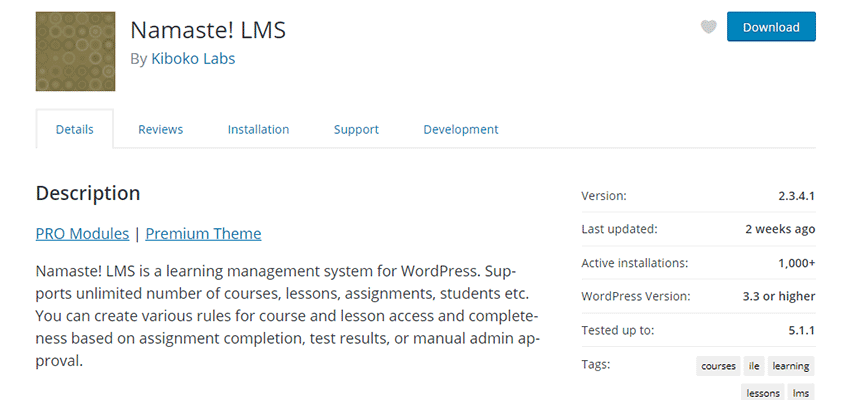As more people look to further their learning online, there has been a growing market for software to help businesses build and sell courses. Known as a Learning Management System (LMS), these niche apps include (more or less) everything you need to get up and running.
Like many other specialty tools, the LMS was at one time standalone, clunky and expensive. However, there have been several options released in recent years that fit all manner of needs and budgets. One of the brightest and busiest areas of LMS development have come in the form of WordPress plugins.
Today, we’ll introduce you to various plugins that will take your standard WordPress install and transform it into an educational powerhouse. They offer features such as course building, eCommerce, and testing – along with a number of other helpful tools. Some are free, some are commercial, but all can bring online learning to your website.
LearnDash LMS WordPress Plugin
One of the best-known LMS plugins, LearnDash, offers a high level of control over just about every aspect of your online courses. It includes a course builder that lets you easily create hierarchical lessons (each with its own set of topics) as well as flexible online testing. There’s also some eCommerce functionality built-in, although the plugin is additionally compatible with WooCommerce. In addition, this commercial plugin offers a number of integrations with plugins ranging from membership (Paid Memberships Pro, MemberPress) to bbPress forums.

LearnPress WordPress Plugin
LearnPress is a free plugin (with multiple Pro upgrade options) that can be used to build and sell online courses. Out of the box, it works with WooCommerce and BuddyPress to help you sell online and communicate with students. There are also several free add-ons that offer functions such as prerequisites, offline payments, and import/export. Pro add-ons enable assignments, the awarding of certificates, and support for many additional payment gateways.

LifterLMS for WordPress
A free option with a number of commercially-available add-ons, LifterLMS offers the ability to build multimedia-rich courses. Courses can be single or multi-instructor, have prerequisites and quizzes. Students get their own dashboard to track progress and access account information. They can also be awarded badges based on their achievements. Site owners, meanwhile, have the option to sell courses or make them available for free.

Edwiser Bridge WordPress Moodle LMS Integration
First thing’s first, Moodle is a free, open-source LMS platform. While it features its own set of powerful plugins, there may be times when you want to integrate your courses into WordPress as well. That’s where Edwiser Bridge – WordPress Moodle LMS Integration comes in. The free plugin adds the ability to sell your Moodle courses via PayPal (WooCommerce support is available through one of a number of commercial add-ons). Other features include syncing between WordPress and Moodle, cross-site registration, plus lots of hooks and filters for custom development.

MasterStudy LMS for WordPress
MasterStudy LMS is a free plugin that lets you build and sell flexible online courses. For instance, your courses can contain a wealth of multimedia, including images, videos, graphs, and slides. Sell online through PayPal or Stripe and build community with the included messaging system. Students can earn certificates for completing a course and even rate courses they’ve taken. The plugin works with any theme, but use it with the commercially-available MasterStudy theme and get even more custom functionality.

Namaste! LMS WordPress Plugin
A free WordPress plugin with a Pro option, Namaste! LMS offers a solid variety of features. Create various rules for your courses, assign user roles to students and use the included grading system to track student progress. Students can also earn course certificates. Note that the plugin itself doesn’t offer testing or eCommerce functionality, but is compatible with Watu for testing and WooCommerce for sales. Pro features include limiting course access, award badges, and lots of extra usability tweaks.

WP Courseware Plugin
WP Courseware offers a full suite of functionality in a commercial plugin. Build courses with a drag-and-drop UI, restrict access, drip content and manage your students. Flexible quiz and instructor management systems are also built right in. There’s also integration with a number of membership and eCommerce plugins, along with support for recurring subscriptions.

WPLMS for WordPress
WPLMS is a bit unique among this group as it is part of a commercial theme (the functionality is not available on its own). That said, it may be a great choice for those looking for an all-in-one solution. Features include a front-end course builder, user activity recording, a notification system, quizzes and even a mobile app. It also integrates with WooCommerce, BuddyPress, and popular membership plugins.

While all of the plugins above have their own unique qualities, they all share a common thread: The ability to quickly and easily create an online learning environment. So, no matter where your area of expertise lies, you will be able to share it with the world without a huge investment in development time or even budget.
Learning Management System (LMS) Plugin FAQs
-
What Are LMS Plugins for WordPress?They are plugins that transform your WordPress site into a platform for online learning, where you can create, manage, and sell online courses.
-
Can I Create Quizzes and Assignments with These Plugins?Yes, most LMS plugins allow you to create various types of quizzes and assignments as part of your online courses.
-
Are These Plugins Easy to Use for Beginners?Many LMS plugins are designed with user-friendliness in mind, so even if you’re new to this, you should find them manageable.
-
Can I Track My Students’ Progress?Most plugins often include tools to monitor and report on your student’s progress and performance.
-
Do LMS Plugins Support Video Content?Some of them allow you to incorporate video lectures and content into your courses.
-
Can I Charge for My Courses with These Plugins?Many LMS plugins integrate with payment gateways, making it easy to set up paid courses.
-
Will These Plugins Work with My Current WordPress Theme?Most are designed to be compatible with a variety of themes, but it’s a good idea to check their specific compatibility.
Top